A Laser Cut Dice Tower
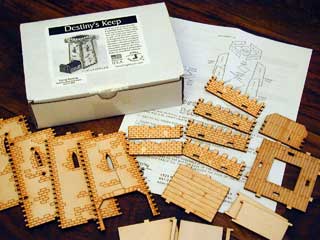
|
|
Laser cut wooden parts
|
This article describes the assembly and painting of a laser-cut wooden
dice tower made by Flying Tricycle.
The company makes accessories for collectible card games and miniature
battles, but this dice tower is somewhat of an odd product of theirs, about
halfway between a miniatures battle structure and a useful gadget for
board gaming.
As we step through its construction, notice how the details and
features make this product so interesting for board gaming.
In the first picture we see all the components of "Destiny's Keep
Dice Tower" which costs $19.95, shipping and handling included.
It comes in a generic box with sparse instructions, but assembly is
easy, and I built my kit without the instructions.
The material is basswood, which I used in construction of my
own handmade dice tower in a previous article.
Flying Tricycle uses 1/8" (3 mm) thick stock while I use 1/16" stock.
When assembled the tower is roughly 6 inches (15 cm) tall and in
scale with 15 mm figures.
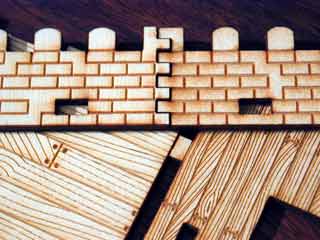
|
|
Precision cut assemblies
|
The main features of the Flying Tricycle dice tower are the precision design
and the laser-etched patterns.
As you can see in this detail photo, the crenellations and brick
work on the ramparts are excellent and much better cut than one
can do with a saw.
The lumber pattern in the floorboards is excellent.
It is difficult to see, but the pattern is fairly deep and not just burned
on the surface.
The channels look very much like an actual squared mortar channel.
It is hard to reach and fill with a paint brush.
Also notice the mortise and tenons for later assembly.
Top quality design.
I immediately became interested in laser cutting my own wood parts, but
the least expensive computer controlled laser cutter I could find on the world
wide web was about $21,000. That's out of my range.
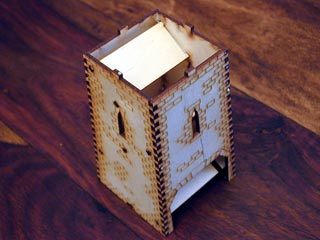
|
|
Assembling the parts
|
In this photo we see the first steps to assembly.
I have glued the three interior dice ramps within the
four walls of the tower.
There are no ridges in the ramps.
Perhaps one modification would be to glue small ribs
in the ramps to help the dice tumble rather than
slide.
Again notice how the edges of the tower are nicely interlocking.
The wood is burned from the laser cut, but this will be
primed and painted later on.
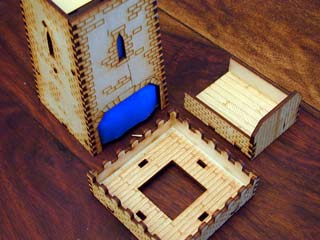
|
|
Sub-assemblies all complete
|
Here are the three major sub-assemblies ready to be primed.
I put masking tape over the doorway and windows so the
interior of the tower was unfinished wood.
In addition to the tower assembly there is a sliding drawbridge and a
battlement for the top of the tower.
The draw bridge slides all the way into the tower,
making an impervious wall to any would be attacker.
It also locks any dice inside the tower for storage.
The battlement is nicely detailed, but here is an instance
of form taking precedence over function.
The floor boards are nice because you can stand
15 mm miniatures on it, but it is too wide for
dice rolling.
The dice often get caught on this floor on the top
of the tower.
One has to have good aim to get all the dice in the hole in the floor.
The design could be improved by halving the width of this flooring,
or by angling it toward the hole to help dice roll in.
In this picture, the glue on the model is still wet.
I used Elmer's wood glue mixed 50/50 with water.
This seeps into the seam and forms a very strong joint.
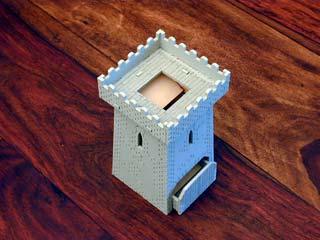
|
|
The tower is primed
|
Here is the completely assembled tower primed with gray spray paint.
Notice how the drawbridge fits into the tower just like
a drawer.
When fully extended it sticks out about 2 inches (5 cm) from the
base.
This is a little bit small for my hands.
It is difficult to scoop out 3 or 4 dice from this cubby hole.
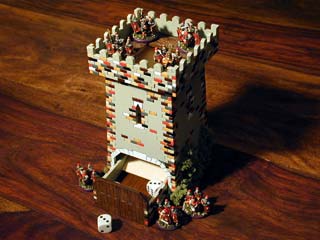
|
|
The finished paint scheme
|
I gave my tower a Rococo look to it.
I painted the bricks white, black, gray, tan, mute orange and brick red.
Together they give the tower a look of stout hearty Lego bricks.
The wooden flooring I painted medium brown and gave it a dark brown
wash to bring out the details of the laser-etched grain.
I glued some scale vegetation to the walls to give it an ivy covering.
Notice the Imperial Romans taking the tower
and holding it for their own.
It will be a sorry barbarian who attempts to steal the dice
from these Romans.
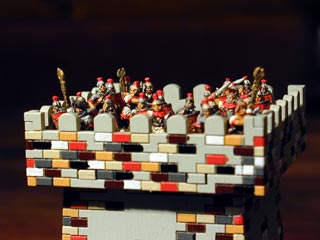
|
|
Romans man the battlements
|
In this final shot, the Romans have crowded the battlements.
It is easy to fit 40 or more Romans on the wall,
complete with spears, swords, and standards.
The pots of boiling oil are heated and ready to drop.
As soon as I cross this draw bridge and enter the tower I will
give the signal and they will
AAAAIIIIIIIEEEEEEEE!







